Verdict
Sony’s dedicated Remote Play handheld slaps a nice, large display into the middle of the brilliant DualSense controller. The PlayStation Portal is an excellent, well-tailored first-party option for PS5 gaming away from your main display. However, this sole purpose will represent a lack of ambition if Sony doesn’t offer cloud gaming through the Portal some day.
Pros
- Best device for Remote Play
- Brilliant execution of split DualSense controller
- Virbrant, large display
- Solid battery life
Cons
- One dimensional
- Missed opportunity for cloud streaming
- Slow-ish charging
- Only Wi-Fi 5 and no Bluetooth
-
Remote Play for PS5 gamesAccess your PS5 over Wi-Fi away from your main gaming display. The PlayStation Portal’s sole purpose is to mirror content from PS5. -
PlayStation Link technologyA new connectivity standard between PS5 consoles, like Portal, and supported audio accessories like the PlayStation Elite buds. It offers rapid pairing, hi-res audio over wireless and no latency. There’s no Bluetooth so this is important. -
Large 8-inch LCD displaySlapped in the middle of a split Dual Sense controller is the 8-inch LCD display that offers a 1080p max resolution with a 60Hz refresh rate.
Introduction
The Sony PlayStation Portal is a handheld device with a single purpose, offering an experience that’s possible to somewhat replicate with your existing phone and your DualSense controller.
It’s also a device with far greater potential than it’s showing in its initial form with highly limited functionality. It’s a head-scratcher that there’s no cloud support here, meaning the Portal can only play games directly streamed from your own PS5 console via a Wi-Fi connection.
However, after spending a week with the PlayStation Portal, not only do I think the Portal is enough, I also think it’s a great purchase for PlayStation aficionados. The experience is tailored well to surpass any existing way to enjoy PS5 games via Remote Play. So let’s dive into my review.
Design and features
- Brilliant, full-featured execution of split DualSense
- Requires wide grip, still feels relatively balanced
- Maintains strong PS5 design language
When unboxing the Sony PlayStation Portal I was struck by how large and especially wide it is. I primarily game on my handheld Nintendo Switch and this just feels like a different proposition. Imagine you’re setting your hands to 9 and 3 to drive a car; this is how holding the PlayStation Portal feels initially. A little bit awkward, a little bit unwieldy, maybe.
Ergonomically, the PlayStation Portal just works, despite a design that looks like two ends were cut off a DualSense controller and glued to an imposingly large smartphone screen.
The entire device measures 14.0 wide x 3.88 deep x 6.0 inches tall and weighs 529g, compared with 6.3 x 2.6 x 4.2 inches and 281g on the DualSense controller.
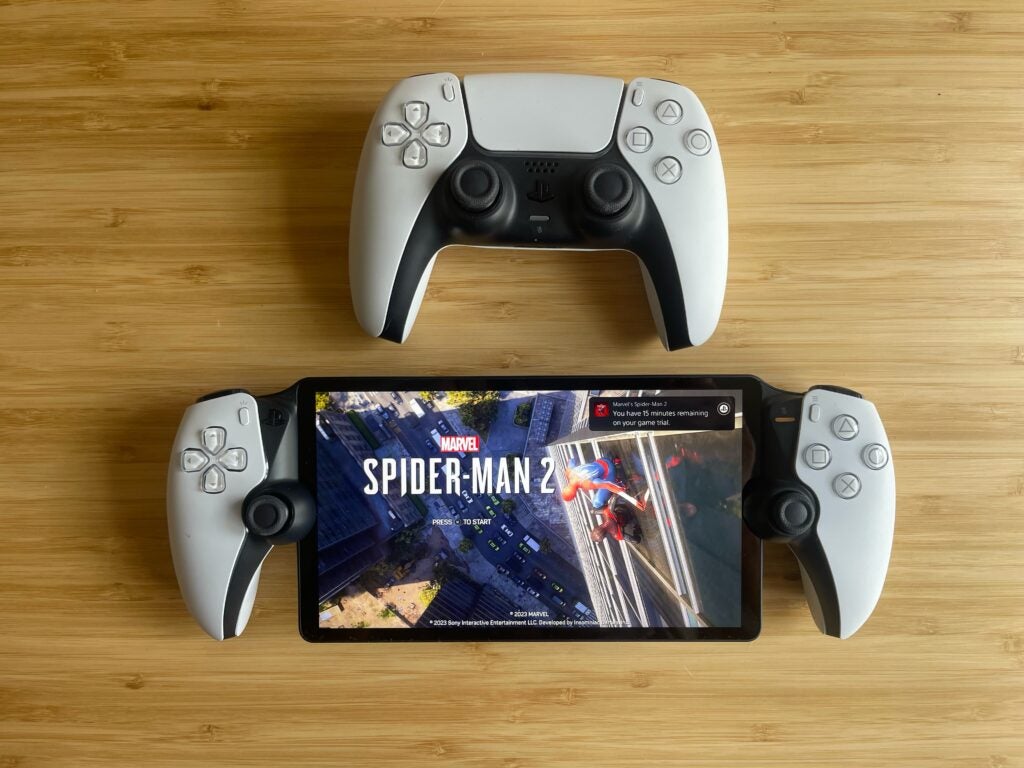
The Portal is easy to hold and everything still feels pretty balanced. The 8-inch tablet touchscreen sits in place of the DualSense’s TouchPad, while the buttons beneath the touchpad on the controller have been integrated higher up for a cleaner design. And, in all honesty, it feels great to hold.
The hand grips are slightly less girthy and less rounded than the DualSense, but the experience remains mostly true to the PS5’s heralded controller.
For instance, the finger travel between the various components – directional pad, left and right sticks, iconic PlayStation action buttons and the triggers – feels the same as it does on the DualSense. And, given there’s support for adaptive triggers and haptic feedback, the experience is authentic. That’s important, because it means an easy transition when switching from the TV to the Portal.
The left and right sticks are a little smaller than on the DualSense, but that doesn’t affect the experience at all. Beyond the main controls, Sony has done well to keep PlayStation Portal as slender as it is. The PlayStation, Options and Create buttons, along with the controls for the mic mute, are on the front of the controller. That enables the 8-inch display to be free from distractions.
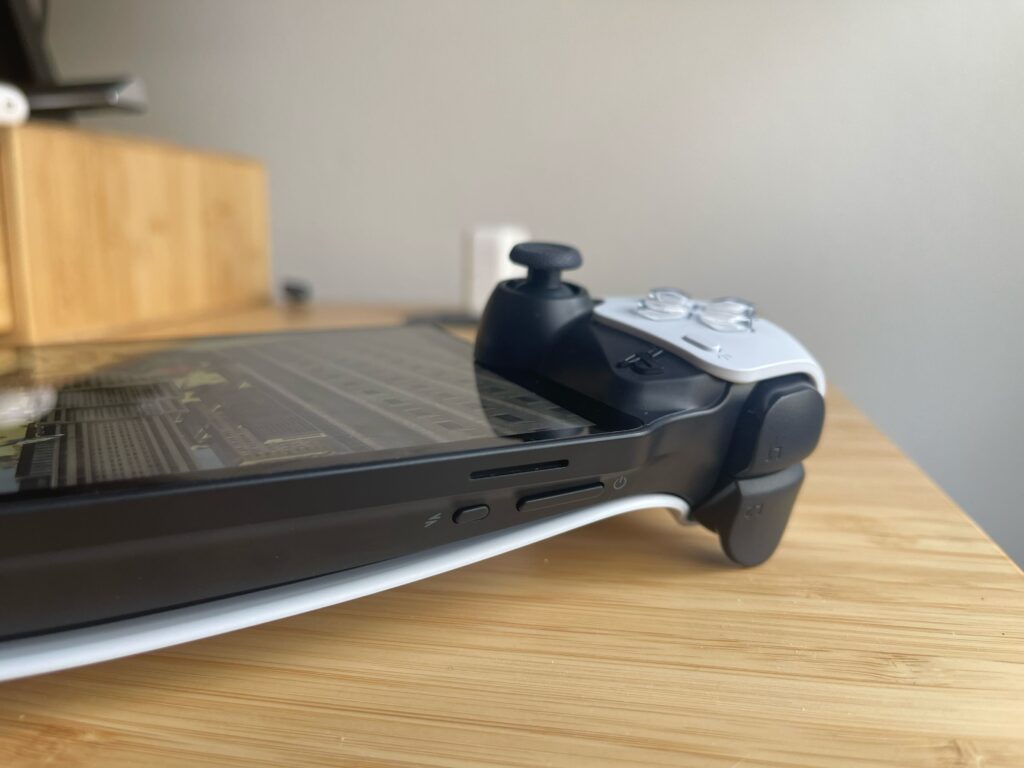
The buttons for power, volume, PlayStation Link pairing and the slim speakers are hidden at the top and just behind the display. There’s also a 3.5mm headphone/headset jack and USB-C charging port on the back of the device, again well concealed although plugging cables into them can be a little fiddly.
When powering on for the first time, the attractive light bar snakes down the gap between the white and black design features that maintain true consistency with the PS5’s design language and the DualSense controller.
Performance
- Remote play works as expected
- Haptic feedback and adaptive triggers carried over from DualSense
Because you’re essentially just playing from your PS5, there’s not too much to tell you about the performance. The processors are very basic Snapdragon offerings (a teardown identified it as a Qualcomm), there’s no SSD on board to store games and not much to speak of in the way of RAM.
The chip is designed simply to be able to power the display, sustain power from a battery, and maintain connectivity with Wi-Fi and PlayStation Link. So, provided you have a stable Wi-Fi connection, gameplay is as you’d expect it to be from a remote screen, as you’re still using the DualSense to control the PS5, simply viewing that content on the remote display rather than your main gaming screen.
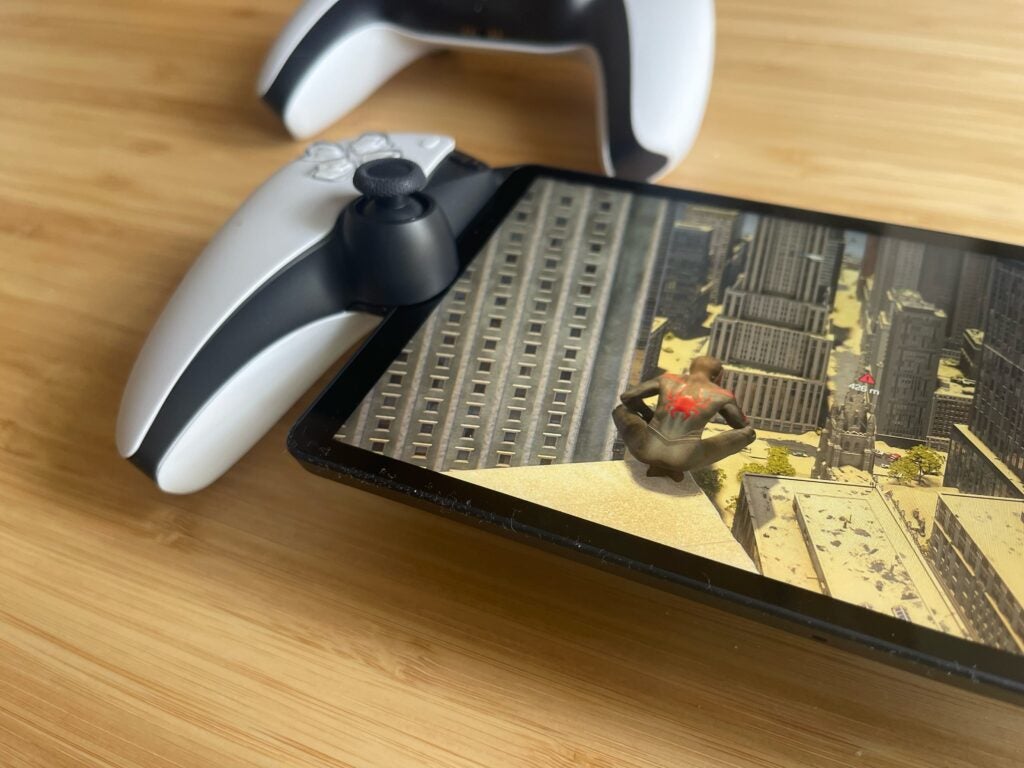
The experience of using the split DualSense is seamless and there’s no drop off in terms of the haptic feedback and adaptive triggers that have made the DualSense.
The more discerning display experts may notice a drop off in the detail when downscaling content from 4K 120Hz to the 1080p 60Hz display, which doesn’t offer HDR. However, the Portal isn’t designed to mirror the PS5’s powerful performance in a handheld device.
Display and audio
- 8-inch LCD display is vivid and crisp
- 1080p res, no HDR and 60Hz refresh rate
- PlayStation Link audio is a breakthrough
Sony has deployed an 8-inch display for the PlayStation Portal, which is an inch (diagonally) larger than the Nintendo Switch OLED and the Valve Steam Deck. The resolution is 1080p and there’s a 60Hz refresh rate. Sony opted to skip HDR, and there’s sadly no OLED option.
I found the display to be bright and vivid at around 75% brightness, which will save you a bit in terms of battery life. Perhaps games like Marvel’s Spider-Man 2 lacked a little brilliance in contrast when compared to my LG OLED set connected to my PS5.
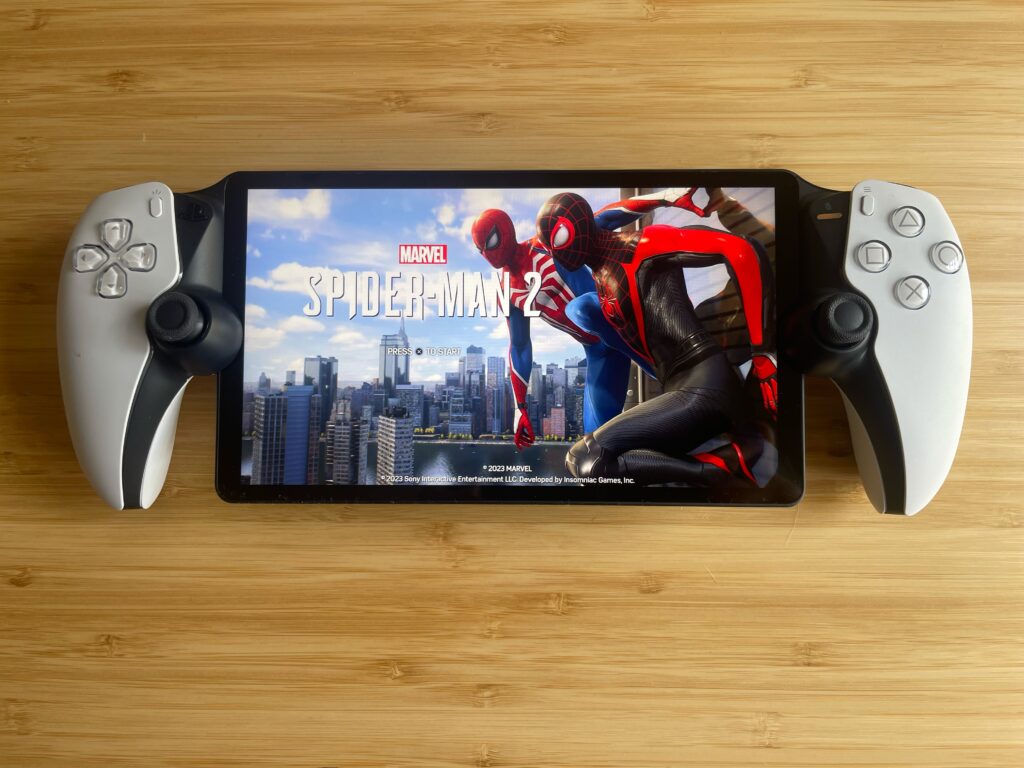
Inherently, there are some issues with reading button prompts and in-game text on a display that’s mirroring content designed to be viewed on a display around 7x the size.
Audio connectivity wise, the headline feature is the new PlayStation Link tech. It is built into the Portal, meaning quick syncing with the new Pulse Explore earbuds or Pulse Elite headset released alongside this handheld. On a PS5 (even on the new PS5 Slim) PlayStation Link requires a USB dongle, but it’s seamless here.
Effectively PlayStation Link offers rapid connection between audio accessory and handheld; non-existent latency, and lossless audio over wireless. It’s a breakthrough, especially combined with the Pulse Explore and Pulse Elite’s Planar Magnetic Drivers in the audio support for the PS5’s 3D Audio. However, you might be wary of paying £200 for this and other £200/£130 on an additional headset just to access PlayStation Link.
Connection with the Pulse Elite headset was remarkably fast and accessible by pressing the dedicated PlayStation Link button on the Portal. That’s a good thing because the built-in speakers are tame (although refrain from being tinny) and there’s no support for Bluetooth. Cynics might say Bluetooth has been left out because Sony wants you to buy the PlayStation Link products. Thankfully, the 3.5mm jack remains for traditional wired connections.
Battery and charging
- 6-7 hour battery life
- Takes almost two hours to fully recharge
Battery life was around 6-7 hours of continuous gaming. Because of the singular purpose of streaming, there’s not a lot that can cause variances in battery life, aside from display brightness.
As I’ve explained, the PS5 is doing all the heavy lifting in terms of processing and graphical power. All you’re doing is mirroring from the console. The lower end processors and memory won’t draw much power either. You can’t stream games from the internet, and you can’t watch movies, listen to music, or use emulators.
Charging speed is a bit of a disappointment though. My testing shows that you get about a minute back per minute on charge. 15 minutes recovered 16% of the battery from flat, when connected to USB-C over the mains, which could probably get you an hour of play. The Portal recovered 36% of battery life from zero after 30 minutes, 66% after an hour, and 88% after 90 minutes.
In the current climate, the PlayStation Portal Portal would have been a great way to save a few quid on the fuel bill if it was able to run independently of the console. Connecting the Portal to PS5 while the latter is in rest mode will simply wake the console up. If the PS5 is turned off, then the Portal won’t be able to run any games.
It would have been great if Sony had figured out a way for the PS5 to remain in Rest Mode, while Portal did its thing, but that’s not in the cards right now. That’s why it’s essential for the cloud streaming functionality to someday free PS5 games from the console, as Xbox has managed to do successfully.
The only independently accessible feature is the Portal’s settings menu which is available by dragging down and into the centre of the display from the top-right corner. You can access Network, System, Display and Brightness, and Controller settings from here. Otherwise, all of the settings you access are mirrored from the console.
Software and connectivity
- Only Wi-Fi 5
- Can be linked to PS5 in Rest Mode
- Wi-Fi in and out of the home
This handheld could be far more capable than it is right now, as it’s basically useless without a PS5 connected to Wi-Fi/Ethernet.
The PlayStation Portal would be the perfect device for PlayStation cloud gaming, akin to what Xbox is offering with Game Pass, but Sony isn’t ready to unleash that functionality just yet.
When powering on the Portal for the first time, it’s immediately apparent just how singular the focus is. There’s literally no option to do anything else but connect to PS5.
After logging into the Wi-Fi network, you’re encouraged to sign into your PlayStation account. If the PS5 associated with the account is powered on or in Rest Mode, you can connect.
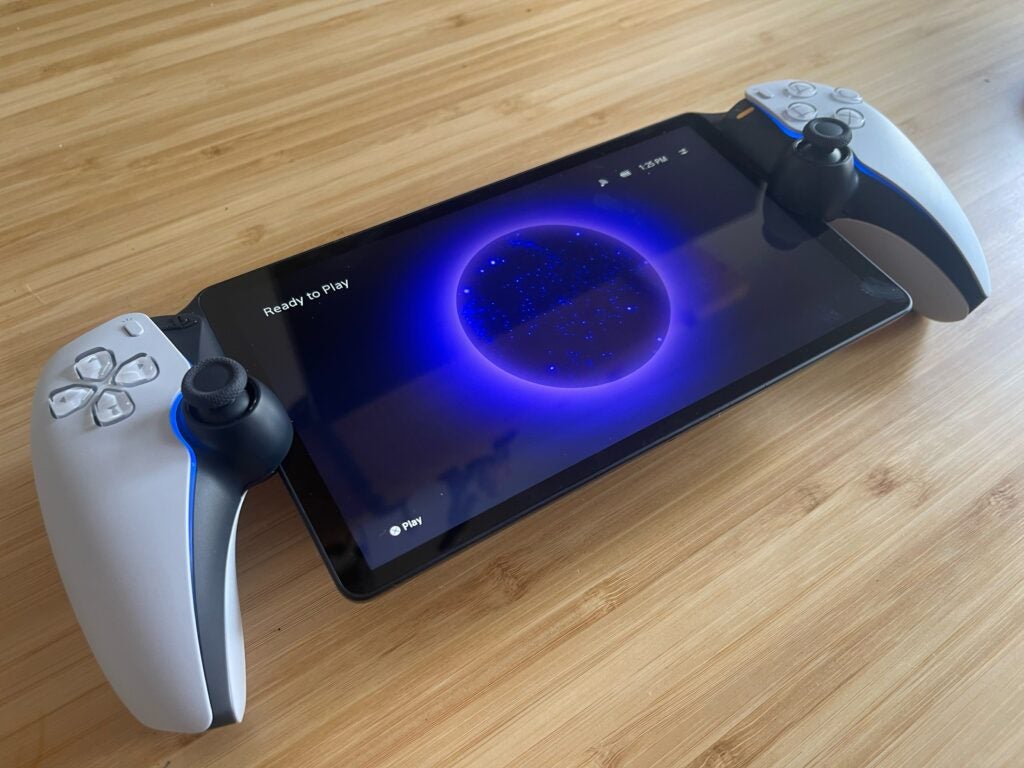
Unfortunately, there’s no support for multiple accounts on the Portal right now, which is an oversight. Individual users need to sign in and out every time if you’re sharing this device.
During the connection process, you’ll be transported through a ‘portal’ and see the PS5’s home screen mirrored on your handheld. You can play games from your library, access the PlayStation Store, access settings and loads more.
You can make purchases from the PlayStation Store and start downloads of PlayStation Plus games to the console, but you can’t stream PlayStation Plus games unless they’re already downloaded. Remember, none of the downloaded content is on the Portal, it’s all on PS5.
If you try to open Spotify, for instance, you’ll be informed it can’t be displayed on the Portal’s screen. The same goes for when you need to sign up for an account with a developer when playing a game like WWE 2K23 for the first time. So sometimes, you’ll have no choice but to refer to your PS5.
So, no media apps, just Remote Play games and critical PlayStation settings. A bit disappointing again, but somehow not a dealbreaker. The proposition will be enough for the dedicated PS5 gamer and this is who this device is aimed at.
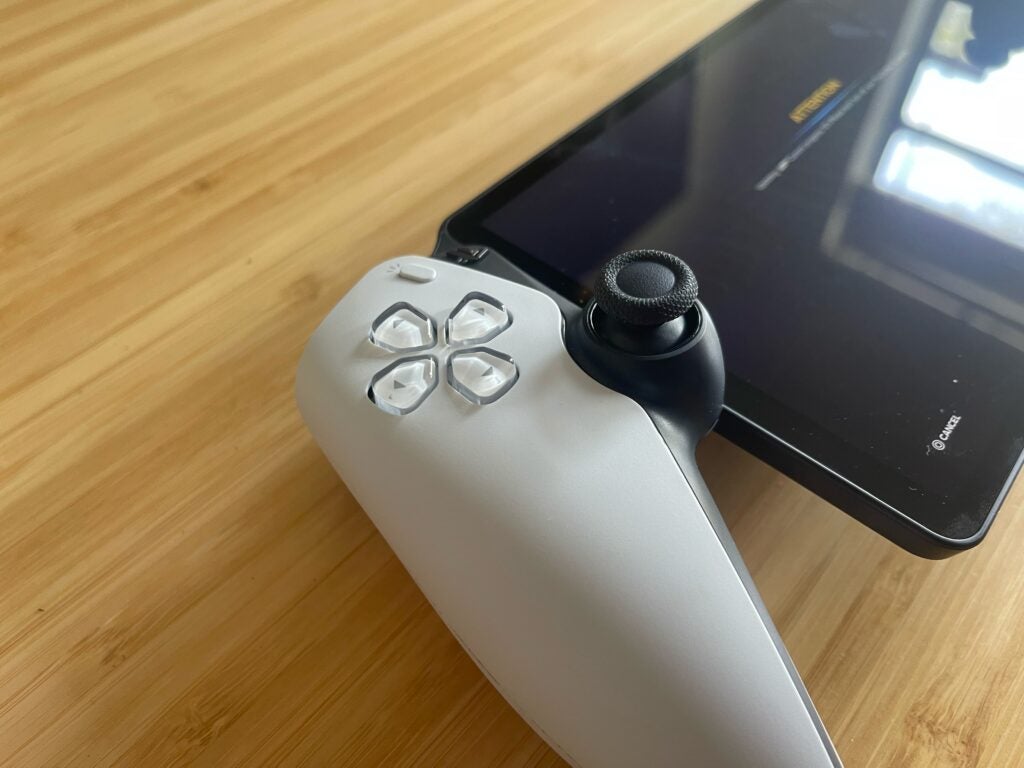
You’ll also learn quickly how the experience depends completely on the strength of your Wi-Fi connection. The Portal only having the decade-old Wi-Fi 5 tech is a cheap-out move from Sony. As a result, you’re hanging out on the 5GHz frequency rather than the more robust and roomy 6GHz frequency. Considering the device relies intrinsically on its ability to play nice with Wi-Fi networks, it’s an unnecessary disappointment.
As for the UI, there’s not much to speak of here. You’re immediately guided to pair with your PS5, so every experience is based upon that. If Sony ever broadens the functionality to allow this device to operate independently of a PS5 then we may see something different. As for now, refer to our PS5 review for our verdict on the UI!
Latest deals
Should you buy it?
You’re a PS5 gamer who doesn’t always have access to primary screen
Remote Play is a handy tool and the PlayStation Portal hardware is by far the best way to experience it.
You want to stream PS5 games from the cloud
You should avoid the Portal if you think this is the door opening to proper PlayStation cloud streaming. That might become a reason to own this device, but it isn’t available yet.
Final Thoughts
The PlayStation Portal executes its sole purpose excellently, as a conduit for PS5 gaming away from the big telly and outside the home.
The split DualSense controller is accomplished perfectly and the display is ideally suited for mobile play. Paired with one of the PlayStation Link compatible headsets you’ll get a great audio experience too. Battery life is solid.
The potential is there to expand functionality to include cloud streaming independently of a PS5, but Sony isn’t prepared to commit right now. I think it will happen eventually and it really must to make this an essential purchase. For now, it’s the best, most tailored way to use Remote Play, and for many that’ll be enough.
How we test
We tested the Sony PlayStation Portal by playing a variety of different games. We also measured the battery life by playing games.
Used alongside the PS5 to stream games for a week
Tested a number of games already downloaded to the PS5 console
FAQs
If the disc is in the Blu-Ray drive when you connect to PlayStation Portal, yes you can run this game.
No, everything you play via PlayStation Portal is essentially mirrored from the PlayStation 5. Without a PS5 it’s useless.
Provided you have a Wi-Fi connection you should be able to Remote log-in to your PS5 from anywhere, as long as the console is connected to your home Wi-Fi and in Rest Mode or powered on.
Verdict
Sony’s dedicated Remote Play handheld slaps a nice, large display into the middle of the brilliant DualSense controller. The PlayStation Portal is an excellent, well-tailored first-party option for PS5 gaming away from your main display. However, this sole purpose will represent a lack of ambition if Sony doesn’t offer cloud gaming through the Portal some day.
Pros
- Best device for Remote Play
- Brilliant execution of split DualSense controller
- Virbrant, large display
- Solid battery life
Cons
- One dimensional
- Missed opportunity for cloud streaming
- Slow-ish charging
- Only Wi-Fi 5 and no Bluetooth
-
Remote Play for PS5 gamesAccess your PS5 over Wi-Fi away from your main gaming display. The PlayStation Portal’s sole purpose is to mirror content from PS5. -
PlayStation Link technologyA new connectivity standard between PS5 consoles, like Portal, and supported audio accessories like the PlayStation Elite buds. It offers rapid pairing, hi-res audio over wireless and no latency. There’s no Bluetooth so this is important. -
Large 8-inch LCD displaySlapped in the middle of a split Dual Sense controller is the 8-inch LCD display that offers a 1080p max resolution with a 60Hz refresh rate.
Introduction
The Sony PlayStation Portal is a handheld device with a single purpose, offering an experience that’s possible to somewhat replicate with your existing phone and your DualSense controller.
It’s also a device with far greater potential than it’s showing in its initial form with highly limited functionality. It’s a head-scratcher that there’s no cloud support here, meaning the Portal can only play games directly streamed from your own PS5 console via a Wi-Fi connection.
However, after spending a week with the PlayStation Portal, not only do I think the Portal is enough, I also think it’s a great purchase for PlayStation aficionados. The experience is tailored well to surpass any existing way to enjoy PS5 games via Remote Play. So let’s dive into my review.
Design and features
- Brilliant, full-featured execution of split DualSense
- Requires wide grip, still feels relatively balanced
- Maintains strong PS5 design language
When unboxing the Sony PlayStation Portal I was struck by how large and especially wide it is. I primarily game on my handheld Nintendo Switch and this just feels like a different proposition. Imagine you’re setting your hands to 9 and 3 to drive a car; this is how holding the PlayStation Portal feels initially. A little bit awkward, a little bit unwieldy, maybe.
Ergonomically, the PlayStation Portal just works, despite a design that looks like two ends were cut off a DualSense controller and glued to an imposingly large smartphone screen.
The entire device measures 14.0 wide x 3.88 deep x 6.0 inches tall and weighs 529g, compared with 6.3 x 2.6 x 4.2 inches and 281g on the DualSense controller.

The Portal is easy to hold and everything still feels pretty balanced. The 8-inch tablet touchscreen sits in place of the DualSense’s TouchPad, while the buttons beneath the touchpad on the controller have been integrated higher up for a cleaner design. And, in all honesty, it feels great to hold.
The hand grips are slightly less girthy and less rounded than the DualSense, but the experience remains mostly true to the PS5’s heralded controller.
For instance, the finger travel between the various components – directional pad, left and right sticks, iconic PlayStation action buttons and the triggers – feels the same as it does on the DualSense. And, given there’s support for adaptive triggers and haptic feedback, the experience is authentic. That’s important, because it means an easy transition when switching from the TV to the Portal.
The left and right sticks are a little smaller than on the DualSense, but that doesn’t affect the experience at all. Beyond the main controls, Sony has done well to keep PlayStation Portal as slender as it is. The PlayStation, Options and Create buttons, along with the controls for the mic mute, are on the front of the controller. That enables the 8-inch display to be free from distractions.

The buttons for power, volume, PlayStation Link pairing and the slim speakers are hidden at the top and just behind the display. There’s also a 3.5mm headphone/headset jack and USB-C charging port on the back of the device, again well concealed although plugging cables into them can be a little fiddly.
When powering on for the first time, the attractive light bar snakes down the gap between the white and black design features that maintain true consistency with the PS5’s design language and the DualSense controller.
Performance
- Remote play works as expected
- Haptic feedback and adaptive triggers carried over from DualSense
Because you’re essentially just playing from your PS5, there’s not too much to tell you about the performance. The processors are very basic Snapdragon offerings (a teardown identified it as a Qualcomm), there’s no SSD on board to store games and not much to speak of in the way of RAM.
The chip is designed simply to be able to power the display, sustain power from a battery, and maintain connectivity with Wi-Fi and PlayStation Link. So, provided you have a stable Wi-Fi connection, gameplay is as you’d expect it to be from a remote screen, as you’re still using the DualSense to control the PS5, simply viewing that content on the remote display rather than your main gaming screen.

The experience of using the split DualSense is seamless and there’s no drop off in terms of the haptic feedback and adaptive triggers that have made the DualSense.
The more discerning display experts may notice a drop off in the detail when downscaling content from 4K 120Hz to the 1080p 60Hz display, which doesn’t offer HDR. However, the Portal isn’t designed to mirror the PS5’s powerful performance in a handheld device.
Display and audio
- 8-inch LCD display is vivid and crisp
- 1080p res, no HDR and 60Hz refresh rate
- PlayStation Link audio is a breakthrough
Sony has deployed an 8-inch display for the PlayStation Portal, which is an inch (diagonally) larger than the Nintendo Switch OLED and the Valve Steam Deck. The resolution is 1080p and there’s a 60Hz refresh rate. Sony opted to skip HDR, and there’s sadly no OLED option.
I found the display to be bright and vivid at around 75% brightness, which will save you a bit in terms of battery life. Perhaps games like Marvel’s Spider-Man 2 lacked a little brilliance in contrast when compared to my LG OLED set connected to my PS5.

Inherently, there are some issues with reading button prompts and in-game text on a display that’s mirroring content designed to be viewed on a display around 7x the size.
Audio connectivity wise, the headline feature is the new PlayStation Link tech. It is built into the Portal, meaning quick syncing with the new Pulse Explore earbuds or Pulse Elite headset released alongside this handheld. On a PS5 (even on the new PS5 Slim) PlayStation Link requires a USB dongle, but it’s seamless here.
Effectively PlayStation Link offers rapid connection between audio accessory and handheld; non-existent latency, and lossless audio over wireless. It’s a breakthrough, especially combined with the Pulse Explore and Pulse Elite’s Planar Magnetic Drivers in the audio support for the PS5’s 3D Audio. However, you might be wary of paying £200 for this and other £200/£130 on an additional headset just to access PlayStation Link.
Connection with the Pulse Elite headset was remarkably fast and accessible by pressing the dedicated PlayStation Link button on the Portal. That’s a good thing because the built-in speakers are tame (although refrain from being tinny) and there’s no support for Bluetooth. Cynics might say Bluetooth has been left out because Sony wants you to buy the PlayStation Link products. Thankfully, the 3.5mm jack remains for traditional wired connections.
Battery and charging
- 6-7 hour battery life
- Takes almost two hours to fully recharge
Battery life was around 6-7 hours of continuous gaming. Because of the singular purpose of streaming, there’s not a lot that can cause variances in battery life, aside from display brightness.
As I’ve explained, the PS5 is doing all the heavy lifting in terms of processing and graphical power. All you’re doing is mirroring from the console. The lower end processors and memory won’t draw much power either. You can’t stream games from the internet, and you can’t watch movies, listen to music, or use emulators.
Charging speed is a bit of a disappointment though. My testing shows that you get about a minute back per minute on charge. 15 minutes recovered 16% of the battery from flat, when connected to USB-C over the mains, which could probably get you an hour of play. The Portal recovered 36% of battery life from zero after 30 minutes, 66% after an hour, and 88% after 90 minutes.
In the current climate, the PlayStation Portal Portal would have been a great way to save a few quid on the fuel bill if it was able to run independently of the console. Connecting the Portal to PS5 while the latter is in rest mode will simply wake the console up. If the PS5 is turned off, then the Portal won’t be able to run any games.
It would have been great if Sony had figured out a way for the PS5 to remain in Rest Mode, while Portal did its thing, but that’s not in the cards right now. That’s why it’s essential for the cloud streaming functionality to someday free PS5 games from the console, as Xbox has managed to do successfully.
The only independently accessible feature is the Portal’s settings menu which is available by dragging down and into the centre of the display from the top-right corner. You can access Network, System, Display and Brightness, and Controller settings from here. Otherwise, all of the settings you access are mirrored from the console.
Software and connectivity
- Only Wi-Fi 5
- Can be linked to PS5 in Rest Mode
- Wi-Fi in and out of the home
This handheld could be far more capable than it is right now, as it’s basically useless without a PS5 connected to Wi-Fi/Ethernet.
The PlayStation Portal would be the perfect device for PlayStation cloud gaming, akin to what Xbox is offering with Game Pass, but Sony isn’t ready to unleash that functionality just yet.
When powering on the Portal for the first time, it’s immediately apparent just how singular the focus is. There’s literally no option to do anything else but connect to PS5.
After logging into the Wi-Fi network, you’re encouraged to sign into your PlayStation account. If the PS5 associated with the account is powered on or in Rest Mode, you can connect.

Unfortunately, there’s no support for multiple accounts on the Portal right now, which is an oversight. Individual users need to sign in and out every time if you’re sharing this device.
During the connection process, you’ll be transported through a ‘portal’ and see the PS5’s home screen mirrored on your handheld. You can play games from your library, access the PlayStation Store, access settings and loads more.
You can make purchases from the PlayStation Store and start downloads of PlayStation Plus games to the console, but you can’t stream PlayStation Plus games unless they’re already downloaded. Remember, none of the downloaded content is on the Portal, it’s all on PS5.
If you try to open Spotify, for instance, you’ll be informed it can’t be displayed on the Portal’s screen. The same goes for when you need to sign up for an account with a developer when playing a game like WWE 2K23 for the first time. So sometimes, you’ll have no choice but to refer to your PS5.
So, no media apps, just Remote Play games and critical PlayStation settings. A bit disappointing again, but somehow not a dealbreaker. The proposition will be enough for the dedicated PS5 gamer and this is who this device is aimed at.

You’ll also learn quickly how the experience depends completely on the strength of your Wi-Fi connection. The Portal only having the decade-old Wi-Fi 5 tech is a cheap-out move from Sony. As a result, you’re hanging out on the 5GHz frequency rather than the more robust and roomy 6GHz frequency. Considering the device relies intrinsically on its ability to play nice with Wi-Fi networks, it’s an unnecessary disappointment.
As for the UI, there’s not much to speak of here. You’re immediately guided to pair with your PS5, so every experience is based upon that. If Sony ever broadens the functionality to allow this device to operate independently of a PS5 then we may see something different. As for now, refer to our PS5 review for our verdict on the UI!
Latest deals
Should you buy it?
You’re a PS5 gamer who doesn’t always have access to primary screen
Remote Play is a handy tool and the PlayStation Portal hardware is by far the best way to experience it.
You want to stream PS5 games from the cloud
You should avoid the Portal if you think this is the door opening to proper PlayStation cloud streaming. That might become a reason to own this device, but it isn’t available yet.
Final Thoughts
The PlayStation Portal executes its sole purpose excellently, as a conduit for PS5 gaming away from the big telly and outside the home.
The split DualSense controller is accomplished perfectly and the display is ideally suited for mobile play. Paired with one of the PlayStation Link compatible headsets you’ll get a great audio experience too. Battery life is solid.
The potential is there to expand functionality to include cloud streaming independently of a PS5, but Sony isn’t prepared to commit right now. I think it will happen eventually and it really must to make this an essential purchase. For now, it’s the best, most tailored way to use Remote Play, and for many that’ll be enough.
How we test
We tested the Sony PlayStation Portal by playing a variety of different games. We also measured the battery life by playing games.
Used alongside the PS5 to stream games for a week
Tested a number of games already downloaded to the PS5 console
FAQs
If the disc is in the Blu-Ray drive when you connect to PlayStation Portal, yes you can run this game.
No, everything you play via PlayStation Portal is essentially mirrored from the PlayStation 5. Without a PS5 it’s useless.
Provided you have a Wi-Fi connection you should be able to Remote log-in to your PS5 from anywhere, as long as the console is connected to your home Wi-Fi and in Rest Mode or powered on.

























